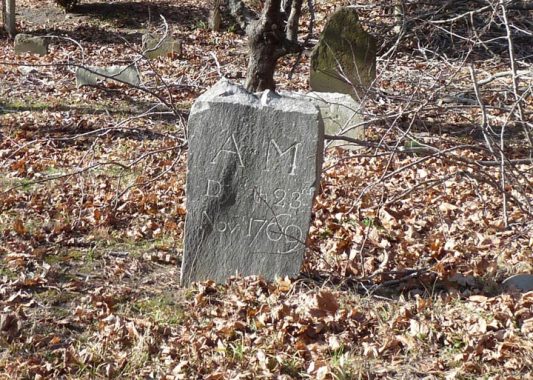
I have mentioned the Moore-Jackson Cemetery before — it’s located in Deep Woodside, on 54th Street between 31st and 32nd Avenues. When the trees are leaved out it appears to be a community garden on the west side of the street, a function it pretty much performs unofficially these days. But this has been a burying ground since 1733, and it has endured lengthy stretches of abuse and revival in a nearly endless cycle. 2021 finds it in one of its more fortunate periods. In January I happened upon it at at a good time, as the slanted sun hit the remaining gravestones at an angle just right to produce a pleasing offset of sun and shadow.
Queens is dotted with minuscule cemeteries, some still existing, some as dead as the people who were buried within, whose remains are blown in the breeze now. Corona used to have a small cemetery on Alstyne Avenue that is long forgotten. The Bunn Cemetery on 46th Avenue and 165th Street in Flushing was, about 20 years ago, rededicated after being cemented over by Robert Moses in the 1930s. Some, such as the Bayside Acacia Cemetery in Ozone Park, have become overgrown with weeds and neglect. Some, like the Brinkerhoff Cemetery, on 182nd Street in Fresh Meadows, have been the centers of a tug of war between developers and preservationists.
Woodside and Elmhurst, Queens were home to the Moore family, the family that gave rise to Clement Clarke Moore, to whom the famed poem The Night Before Christmas is credited. Clement was the great-great-great grandson of Reverend John Moore, who became the first minister in the town of Middleburg (today’s Elmhurst) in 1656. His son, Captain Samuel Moore, built a house near today’s Broadway and 83rd Street, today the site of the Moore Homestead Park; Samuel Moore Jr. built a farmhouse near 31st Avenue and 54th Street in 1701 (demolished about 1900) and owned about 100 acres of surrounding woodland in the 18th Century. Family descendant Nathaniel Moore, Jr. stipulated in his 1827 will that his real estate on either side of Bowery Bay Road (today’s 51st street) be sold after his death, with the exception of the family burial ground, located today on the west side of 54th Street between 31st and 32nd Avenues.
The cemetery was established by 1733 (the date of the earliest known burial) and has been known as the Moore-Jackson Cemetery since John Jackson married into the family and added to the cemetery’s acreage. He was, however, buried in the churchyard of St. James Episcopal Church on Broadway in Elmhurst. The last interment in the cemetery was in 1867.

The Queens Topographical Bureau surveyed the cemetery in 1919 and was able to locate 42 identifiable monuments, which were inscribed on a survey map that you can find reproduced in Woodside: A Historical Perspective by Catherine Gregory (Woodside on the Move, 1994). When construction of the houses you see above began in 1924 the cemetery was used as a rubbish dump. The NYC Department of Health ordered it cleaned of weeds and litter, and by then it was so overgrown that workers were amazed to discover headstones within. The chain link fence was erected in 1956, but the cemetery continued to be plagued by neglect at times. By the 1990s a more concerted effort was made and the cemetery’s condition has stabilized.
There are just a handful of monuments remaining of the 42 that the topographical survey found in 1919, and most are in the back (the 51st Street side, out of range of my zoom lens. But a couple do stand out, including Augustine Moore’s well-preserved 1769 stone which is right in the front. “x” was occasionally used to separate initials in this era. Records show that he was the son of Samuel Moore, Jr, and died at age 17.

Nearby is Samuel Hallett Moore’s stone, which reads: In memory of Samuel Hallett Moore, son of David & Jemima H. Moore, who departed this life June 26th, 1813 aged 23 years, 5 months & 15 days.
The Halletts are an old western Queens family: they were among the original settlers of Long Island in the 1600s and are remembered by Hallett’s Cove, an indentation of the East River at Astoria Village.

This one is especially tough to make out; it was apparently relocated from the back of the cemetery, which is where the QTB survey placed it. In any case, according to the list of gravestone inscriptions in Gregory’s book, it reads: In memory of Margaret, daughter of Bernard and Deborah Rapelye, who departed this life the 7th of October, 1790, aged one year and 11 months.
The Rapelyes, or Rapeljes, too, are in a longstanding Dutch immigrant family in Long Island going back to the 17th Century.

That’s about it for the readable gravestones, which have deteriorated over the centuries. I was only able to shoot through the chain link fence…

…but in healthier times, you are vouchsafed to enter, with or without a penitent’s hood, on Saturdays from 9 to 12.
As always, “comment…as you see fit.” I earn a small payment when you click on any ad on the site.
5/13/21


2 comments
The headstones seem to be made of brownstone.
I guess them the same Rapelyes family that are named after Rapelye st. in Carroll Gardens.
As a child living in the Woodside projects , Friends and I would BBQ there (Moores) on our walk to LaGuardia airport. Was very run down back then I heard it was renovated years later. Would like a return visit as an adult pay my respect to the dead.